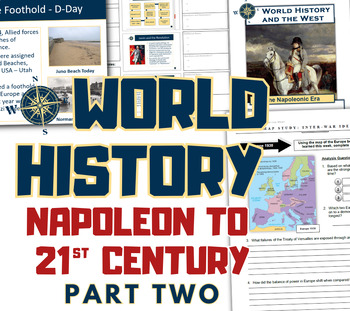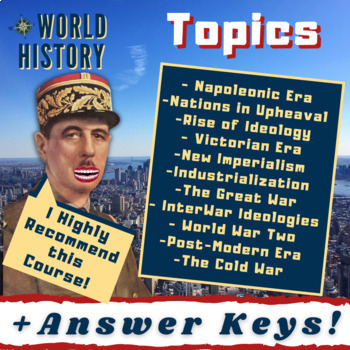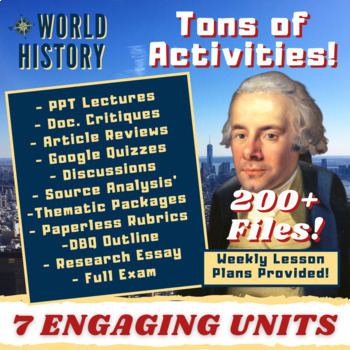World History Course 2 - Complete Curriculum - Projects, Activities & Lessons
- Zip
Description
FREE Course Samples! A time-saving and engaging course created by an experienced educator covering from the Napoleonic Era to the 21st century. Topics include Napoleon, Liberalism vs. Conservatism, Communism, Nationalism, World War 1 and 2, Cold War, Conflict in the Middle East, Reagan, Thatcher, and more! Each week is a new engaging topic with all the teacher resources provided!
Be sure to download the FREE preview for tons of examples detailing how the course works. An outline of a typical week in the course is also attached!
Reviews from PART 1 of the Course (Part 2 has the same design):
⭐️⭐️⭐️⭐️⭐️The best history course packs out there! Always so easy to use and follow. It was very helpful as it was my first year teaching a world history course.
⭐️⭐️⭐️⭐️⭐️ A great variety of wonderful assignments, power points with guided notes. The mapping and video assignments were engaging and allowed students to learn about this topic through different mediums. Excellent resource. Thank you! - Maria (Review from the Exploration and Encounter unit)
For Part I, covering from the Renaissance to the French Revolution, click here.
Location: Western Europe, the Americas, Africa, and Asia
Time Frame: 1800 - 2000s
Topics (7): The Napoleonic Era, Revolution and Upheaval (1815 - 1848), The Victorian Era, The Great War, Inter-War Ideologies, World War Two, and the Post-Modern Era.
Some common sub-topics: William Wilberforce, the Revolutions of 1848, Industrialization, acquisition of colonies, Otto Von Bismarck, conservatism vs, liberalism, Karl Marx and communism, the rise of nationalism, fascism, the United Nations, the European Union etc.
Also includes several research essay options that evaluate the legacy of the West and a final exam.
A Typical Week:
- Monday - The central question of the week is introduced (eg. Did World War Two represent the preservation of western democracy or the emergence of a new world order?) Students listen and view an engaging lecture accompanied by an innovative graphic organizer - see FREE preview. This helps students gain knowledge as they work towards answering the central question by the end of the week. Teacher notes are provided with the lecture.
- Tuesday - Students view an informative documentary that purposefully provides another angle on the topic. A documentary critique sheet is provided to help students gather evidence.
- Wednesday - Students complete a map study, textbook summary activity, or similar activity. Great for visual learners!
- Thursday - This day is used to evaluate primary or secondary sources, complete an article analysis' or work on the final research essay.
- Friday - Students are now informed on the topic and able to fully evaluate the central question of the week! Students start off by completing an interactive Google Quiz. Next, they work on a thematic package which focuses on the central question of the week as well as evaluating examples of change vs. continuity, transformational change, concepts that work together, and prominent themes. This package is all critical thinking through and through. Alternatively, these tasks can also be completed in discussion format as a class or through FlipGrid for oral learners. Rubrics included! By the way, all the weekly central questions appear on the exam! There is a very defined direction in the course that students are working towards. This is key when World History can be so broad.
Resources Included:
- Paperless Weekly Planner: Each week a highly organized planner is provided to guide you through the topic. The paperless planner can be used for other courses too! See preview.
- Central Question: Each week the topic revolves around a central question (eg. Why did liberalism fail to prevent the rise of fascism and communism during the inter-war period?) The resources and activities completed throughout the week will help students to evaluate the central question. This is the focal point of the week. Each central question also appears on the final exam! There is a very defined direction in the course.
- Dynamic Lecture: A clearly organized PPT lecture often interspersed with interesting video clips to keep students engaged is provided. Creatively designed with visual appeal. Additional teacher notes are provided below most slides.
- Innovative Graphic Organizer: Not a regular student note-taking sheet! A lot of thought has been put into developing this graphic organizer to help students organize, synthesize, and, ultimately learn. The PPT slides have already been added to the graphic organizer. See the free sample included! This can be completed paperlessly by students or printed!
- Documentary Critiques: Students watch a documentary about the topic of the week. Follow-along sheet provided.
- Article Analysis': Students complete tasks based on an article reading: identifying the author's message, content questions, connections to the topic, prominent themes, vocabulary, and a deeper thinking question. This is often completed in small groups.
- Map Studies: Students often view animated maps about the topic of the week and complete associated tasks. These are great for visual learners! IMPORTANT: these mapping activities require a subscription to "the-map-as-history.com" (talk with Caroline for a limited subscription). This is NOT included in the purchase. If you choose not to use these mapping activities, alternative activities are included as a replacement in the form of article critiques and textbook chapter summaries utilizing an innovative graphic organizer. There is also a "Generic Activities" folder for other activities to choose from.
- YouTube Clip Analysis': There are many great channels devoted to creating engaging videos. Many are utilized throughout the course! Students are given analysis tasks while viewing each video.
- Primary Source Analysis: From time to time, students evaluate a primary source relating to a topic. (eg. "Conditions in Manchester by Frederich Engels)
- Google Quiz: Students take an interactive quiz to assess their basic knowledge of the weekly topic. Each quiz is based on the topic lecture. Here is a sample from one quiz: free quiz here
- Engaging Discussions: Students often discuss the central question of the week, plus more present-day questions relating to power, decision-making, and, ultimately, the development of the West.
- Thematic Package: The culmination of the week is to complete a critical thinking thematic package. The resources mentioned above prepare students to complete the activities in this package. These "deeper-thinking" activities include: identifying central and connecting issues, prominent values of the time, change and continuity, broader themes, and, finally, an in-depth analysis of the topic central question. Paperless rubric included! Two alternatives to the physical package are provided: Flipgrid oral presentation for students who express their learning orally and a class-wide discussion template to change things up every once and while!
Other Items:
- Answer keys! Very clearly outlined keys to help you better evaluate student learning.
- Paperless Rubrics: Rubrics for the thematic package, DBQs, and midterm are provided. These paperless rubrics tabulate, can be "cleared", and provide ready-to-use drop-down comments on improvements. Makes marking much easier!
- A DBQ template and paperless rubric are provided for those wishing to align this course more closely with AP standards. DBQs (Document-Based Question Essays) are a great way to help students interpret primary resources as well!
- Research Essay: Three versions of the research essay are provided. Each encourages students to evaluate the legacy of the West in various areas.
- Final Exam and Concluding Tasks: Three different discussion options are included along with review materials to wrap up the class. There is also a comprehensive exam comprised of a knowledge section, a central question component, and a short essay section.
- Additional Activities: 15 additional templates are provided if you wish to add to the course (eg. graphic organizer, textbook chapter summary, etc.)!
In Ontario, this course is CHY4U, "The West and the World." In other provinces or states, this course will fit Western Civilization, European, or World History course requirements. A great fit with Common Core as well as AP courses in the US. This is Part II of the course.
Philosophy:
This course includes a diverse range of activities intended to engage students and develop vital critical thinking skills. These resources are intended for gr. 11 or 12 students as a stepping stone to independent learning beyond high school. As you progress through the topic, the resources intentionally move from knowledge to application and critical thinking. In order to provide a focal point on what can be a broad topic, the weekly resources are built around a central question which is introduced at the beginning of each topic and evaluated in-depth by students as they move through the resources. These resources are both paperless and printable!
Complete Course? Other Topics?
Part I of the course is already available!
If you are interested in only buying specific topics from this course, check out the link below for options:
Additional Bundles and Resources
Interested in other courses? Check out the following:





